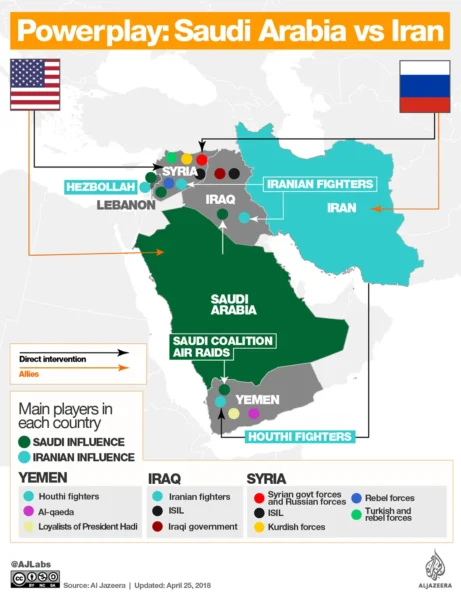Saudi Arabia is a region that, throughout history, has been characterised by the traditional values of society, and a strong emphasis on the importance of religion, which has created a foreign policy agenda shaped by the cultural identity of the Kingdom. The arrival of Prince Mohammed Bin Salman after the death of King Abdullah in 2015 meant a shift in foreign policy agendas, which now has become more impulsive, rash and unpredictable than before. These shifts do not only encompass the political balance in the Middle East–with powerhouses such as Iran–but also in political changes which undermine the classic Saudi tradition. The Kingdom now seeks an increase in foreign investment by looking to sympathise with Western identities and values to attract tourism and investors.
Saudi Arabia finds itself in an era where, while Iran is the core of foreign policy concern, it also stresses the importance of modernising the system, drifting away from the conservative approach the House of Al Saud has taken historically for decades. Notably, the arrival of MBS (Mohammed Bin Salman) to power has been the factor behind this shift in foreign and domestic policy, where there is a psychological component behind the change that has led the prince to adopt unprecedented actions and policies compared to his predecessors in power. At the beginning of his mandate, foreign policy agendas became “an IMAX thriller on fast forward”.
Pre-MBS Foreign Policy
Pre-MBS (Mohammed Bin Salman) foreign policy was characterised by pragmatism and balance of power in the Middle East through a careful and indirect approach. This contrasts the impulsive and interventionist foreign policy line that MBS decided to take when he came to power. While Saudi Arabia’s interest was to position itself as a regional leader, the Kingdom occasionally became directly involved in armed conflicts–stability to promote economic growth has always been critical in Riyadh’s foreign policy agendas.
The nature of Saudi engagement in a fight for power against Iran manifested in proxy nature across the Middle East as a result of a long-standing rivalry with Iran. It is a historic rivalry where Saudi Arabia has sought counterbalancing dynamics to contain the influence of Shia Islam, positioning itself as the leader of Sunni groups to promote Wahabbi influence as part of its containment strategy. In this way, Saudi Arabia formed coalitions with Sunni-majority countries as a strategy of containment against Tehran. Although religion is not the leading actor in this rivalry, it is a pressure point, influencing the country’s identity, which is reflected in the foreign policy antagonism between both states.

From Troublemaker to Diplomat? The Arrival of a Millennial Prince
In the history of the modern state of Saudi Arabia, Crown Prince MBS (Mohammed Bin Salman) has been a very particular figure, perceived by many people as progressive, empathising with the young Saudi population through a more permissive governmental stance, starting with the prohibition of the religious police from making arrests, allowing women to drive without the supervision of a male guardian, and allowing men and women to mix in public without fearing arrest. These reforms changed the air from a strictly conservative and lax Saudi Arabian state to a more Western-like, “progressive” state.
The arrival of the Crown Prince signified a divorce from the tradition of the Al Saud House, provoking antagonisms within the royal family. His foreign policy agenda is independent of advice and consultation. Instead, the young, pragmatic, self-confident leader relies on his own criteria. The fast-forward rearrangement of the government within its ten first days in office has allowed MBS to make decisions without external approval. The circumstances in which MBS grew up have caused resentment towards some family members, explaining his motivation to break from the traditional ruling structure of the Al Saud House and establish a new foreign policy style to push forward his Vision 2030 development plan for Saudi Arabia.
As a result, the arrival of Prince Salman to power was followed by a series of unprecedented actions risking Saudi Arabia’s economic and political stability, while aggravating regional conflicts. These actions did not lead to the desired outcomes; instead, they provoked a backlash against stability and a negative narrative against the young leader in Shia-dominated territories. Everything started with the Saudi military intervention in Yemen to fight the Iran-backed Houthi rebels and restore the government– an action that backfired Saudi Arabia by destabilising the region and straining relations with Iran, shifting from proxy-style conflicts to direct intervention.
The new foreign policy agenda signified a change towards a confrontational approach, with Iran at its core positioned as Saudi Arabia’s main regional adversary. This event was not the only one causing Saudi Arabia’s diplomatic isolation from Iran; the execution of Shiite Sheik Nimr al-Nimr signified further polarisation and divides based on cultural identity and religious tribalism, an event condemned by various human rights organisations. This action not only deepened the sectarian divide but also deepened the fear of criticising governmental actions, primarily silencing Shia minorities in the Kingdom. This led to a series of demonstrations in Iranian cities and attacks on Saudi embassies by Shia groups. The result? Diplomatic breakdown.

A Foreign Policy Shift
Although the beginning of his mandate signified a shift towards an aggressive and responsive agenda with other regional powerhouses, there has been a shift in foreign policy in terms of rival neighbours throughout MBS’s administration. Nevertheless, what can explain such a drastic shift in the lapse of a couple of years, despite millions of dollars poured into the actions committed by MBS, such as intervening to fight the Houthi movement and contain Iran’s influence? The only explanation for this shift is personal motivations or the failure to reach the desired goals for Saudi Arabia through these actions. Instead of being able to establish a Kingdom as an influence in Shia-majority territories, it furthered instability in the region by intensifying the fight against Iran.
The Vision 2030 development plan envisioned by Crown Prince MBS (Mohammed Bin Salman) can also explain his motivations for taking such a drastic policy shift just a few years into his time in power. To achieve his goals, regional stability is needed to attract foreign investment, diversifying its economy and deepening economic ties with other nations. This stability is critical for de-escalating the conflict with Iran to restore diplomatic relations in 2023. The approach towards Iran has undergone significant changes, shifting from a robust foreign policy approach focused on confrontation to one focused on development and economic diversification, leaving proxy-fighting with Iran as a side dish.
MBS’s (Mohammed Bin Salman) new foreign policy approach is based on diplomatic relations and multilateral dialogue with Middle Eastern neighbours to resolve long-running conflicts and establish smoother relations. Indeed, in the past years, MBS (Mohammed Bin Salman) has acknowledged the importance of cooperation in the region, even suggesting that Saudi Arabia and Iran could work together to promote regional stability. These words show the opposite direction MBS decided to take in recent years, “contrasting sharply with earlier statements about Iran, including the comparison of Iranian Supreme Leader Ayatollah Ali Khamenei to Hitler and hinting at his interest in increasing Saudi subversion in Iran.”
The new international affairs agenda is pretty much centred on showing off that Riyadh is “better” than Theran and other “evil rivals”. It will be critical for MBS to demonstrate to Iran and its neighbours that his development plans, governance, and diplomatic efforts have led the Kingdom to success, stability, and modernity, “making a long-term bet” that the success of his domestic reforms will inspire those dominated by Iran and Shia majorities to change eventually by challenging the ideological status-quo of Shia majorities and demonstrate the possibility of an alternative way of governance to the ones exerted by Iran backed groups like Hezbollah, The Houthi movement in Yemen, Shia Militias in Iraq and Shia militias in Syria. A change that Saudis hope will eradicate the Middle Eastern anti-Saudi narrative.
Featured image by The Economist (2023).








King Abdullah was the one who died in 2015 and not King Salman- the father of MBS. Seeing such a mistake in the first paragraph kind of messed with the credibility I felt for the rest of the article.
Thank you for pointing out the error regarding King Abdullah and King Salman in the first paragraph. I deeply appreciate your attention to detail and completely understand how such a mistake could affect your perception of the article’s credibility. It has been corrected and we will take greater care in fact-checking in the future. Thank you again for your comment.